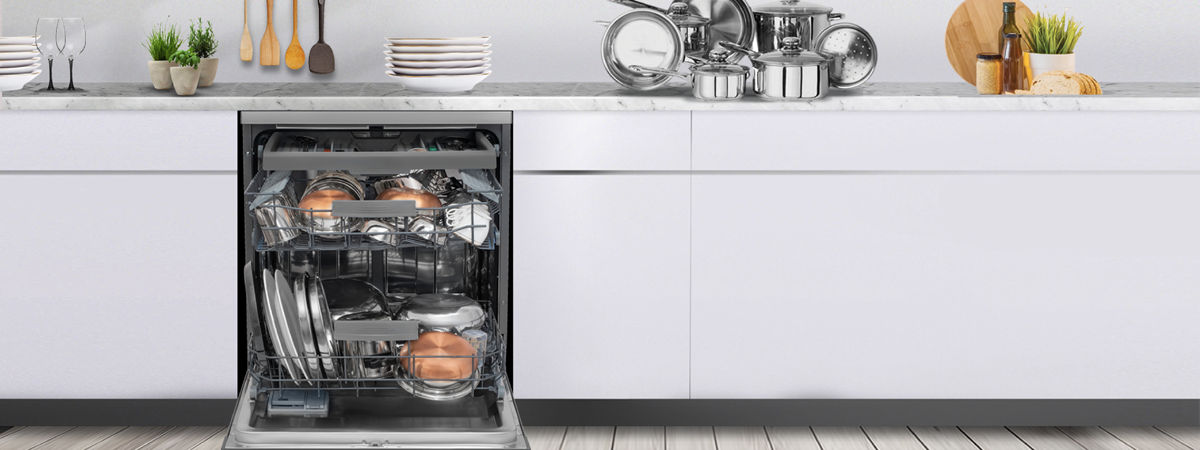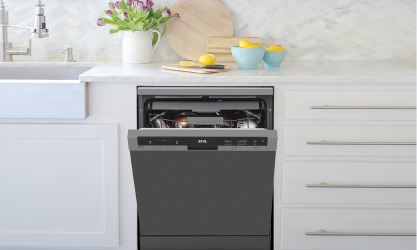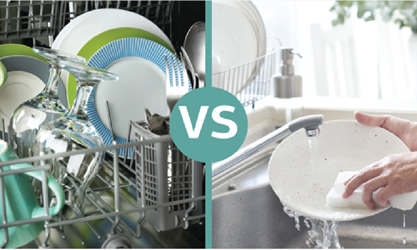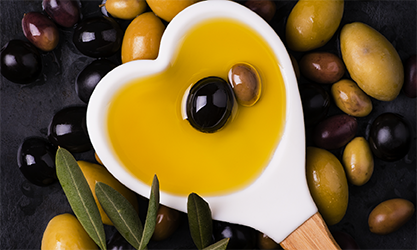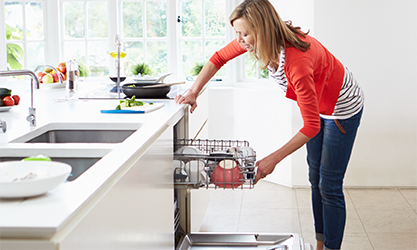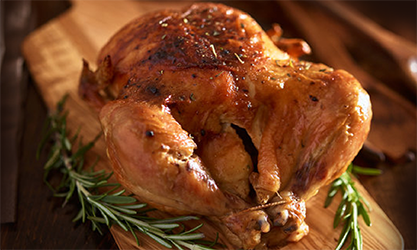Are you new to using a dishwasher?
If you are planning to purchase a dishwasher or just bought one, there are these questions that pop up on how to use a dishwasher correctly or how to get the best performance out of a dishwasher.
Here’s how you should use a dishwasher for best performance in 3 main steps:
Click below to jump to a topic:
Below we explore in detail these processes on how to use a dishwasher.
How to Load the Dishwasher
Loading the dishwasher in a correct manner is crucial in getting perfectly clean utensils.
Step 1: Scrape leftovers/rinse utensils
Just like you don’t toss your utensils with bits of food into the sink for fear of your drain getting clogged, you shouldn’t put the utensils directly inside the dishwasher. Just scrape off leftover food and condiments or do a light rinse of the dishes before placing them in the dishwasher.
Step 2: Load the bottom basket
For greater convenience to you and proper placement of dishes, always load a dishwasher from the inside out. On the bottom basket/rack, place your larger utensils such as pans, kadhais, pots and casserole dishes. Place them upside down and facing the spray nozzles for better cleaning.
- Place plates in the plate holders.
- Indian stainless steel plates (which have bigger ends) should be placed on alternate racks, which will allow water to flow on their both sides.
- Silverware and stainless steel should not touch each other, which may result in a chemical reaction during dishwashing.
Step 3: Load the top basket
Place smaller dishes like bowls, mugs, cups, glasses and small plates on the top basket/rack of the dishwasher. These should also be placed upside down at an angle to allow water to be sprayed inside them for a thorough wash.
- Delicate crockery such as glasses should be placed at an angle to prevent them from moving during dishwashing.
- Place the ladles, spoons and forks on the top rack if your dishwasher has the placeholder or else put them in the space designated as per user manual.
Step 4: Use correct quantity of dishwasher detergent
Use the appropriate dosage of dishwasher detergent as specified on the label and not more even if your dishes are dirty or greasy. Adding more detergent will not make the wash quality better but, adversely, leave detergent residue on dishes.
- Dishwashing salt and rinse aid should also be used as per dosage instructions.
- If using dishwasher tablet, put just one per wash.
- Do not use the handwash detergents in dishwasher.
| Loading a dishwasher: Warnings and tips
|

How to Run the Dishwasher
Running the dishwasher using the most suitable program ensures optimal wash performance and greater efficiency.
Step 1: Choose the lightest cycle
Whenever possible, run the lightest cycles such as eco wash or quick wash in many dishwashers. Light cycles are both energy efficient and require less water. Shorter programs (30-50 min) are good for washing lightly soiled utensils and plates. Your breakfast and snacks dishes and utensils that are not too dirty can easily be washed using a light cycle. Normally these programs do not include the drying step; you may choose extra dry if available.
Step 2: Run an intense cycle for dirty utensils
Dirty dishes with oil and masala stains and those used for baking need a more intensive dishwashing cycle for them to get thoroughly cleaned. While dishes that are moderately dirty can be washed with a normal wash cycle, those with stubborn stains may need a heavy wash program or high-temperature wash.
Step 3: Choose between dry program and air dry
Running a dry program is useful when you want dishes for immediate use, while many dishwashers have a steam dry option for extra hygienic dishes. However, if you are not in a hurry to use the utensils, you can always let them air dry. This will help you save energy.
| Running the dishwasher: Warnings and tips
|

Also Read>> Frequently Asked Questions about Dishwashers
How to Clean the Dishwasher
Regularly cleaning a dishwasher not only enhances its wash performance and efficiency but also reduces odour formation and improves its life.
Step 1: Clean the dishwasher exterior
To begin with, clean the outside of your dishwasher to remove food stains, finger marks, water stains, etc. If you have a plastic dishwasher, you can clean it using soap water and sponge or an all-purpose appliance cleaner. Use a kitchen appliance cleaner or glass cleaner on dishwashers made of stainless steel.
- However, don’t spray the appliance cleaner/glass cleaner directly on a dishwasher as it may damage the electronic parts. Take a cloth, rag towel or paper towel, apply some cleaner on it and then wipe off the dishwasher.
Step 2: Clean the filter
Filter cleaning is crucial to avoid clogging of the dishwasher drain and for its efficient performance. These built-in filters are usually located near the bottom basket/rack, where they trap large food particles and prevent clogging. Refer to your dishwasher user manual, take out the filter, wash it using warm water and soap, and then fit it back in place.
- If your dishwasher use is regular, then you should clean the filter at least 1-2 times a month. It is a simple task that hardly takes any time at all.
- If you pre-rinse your dishes, then the filter may not get clogged with large particles but may still accumulate grime that needs to be cleaned.
- You can use a brush or sponge to scrub out grime and particles stuck in the filter.
Step 3: Clean dishwasher accessories and removable parts
Removable parts such as utensil placeholders can be taken out and washed in the sink. Run them under tap water to wash off food leftovers. If the parts are quite dirty, clean them using a brush or sponge to remove oil and grease stuck on them.
Step 4: Clean the tub
Although a good dishwasher is a self-cleaning appliance, over time it may accumulate grime. If you wish to thoroughly clean it once in a while, it is quite easy. Use agentle cloth or paper towel to wipe off food residue, debris and grime from the inside and bottom of the dishwasher and clean the rubber gasket. Now place white vinegar in a dishwasher-safe cup or bowl on the top rack, run the hottest cycle but skip the drying program, instead opening the dishwasher door and letting it air-dry.
- Once the cleaning cycle ends and the dishwasher is air-dried, wipe the insides with a soft cloth or paper towel.
| Cleaning the dishwasher: Warnings and tips · To avoid and remove unpleasant odours in your dishwasher and utensils and keep them fresh and deodorised, you can use a dishwasher freshener. Just make sure it is natural and safe. · If the rubber gasket has mould or mildew on it, refer to your instruction manual for cleaning it with an all-purpose cleaning. · Some cleaners might damage or harm the gasket. · Do NOT use bleach to clean a stainless steel dishwasher. Bleach will damage it. |
Also Read>> Top Reasons Why You Should Buy an IFB Dishwasher
Following the above steps will help you in making your dishwasher experience not just easy but safe. Just load, run and clean your dishwasher in the proper manner and enjoy hassle-free dishwashing.
Also Read>> Dishwasher vs Hand washing: Which is better?



